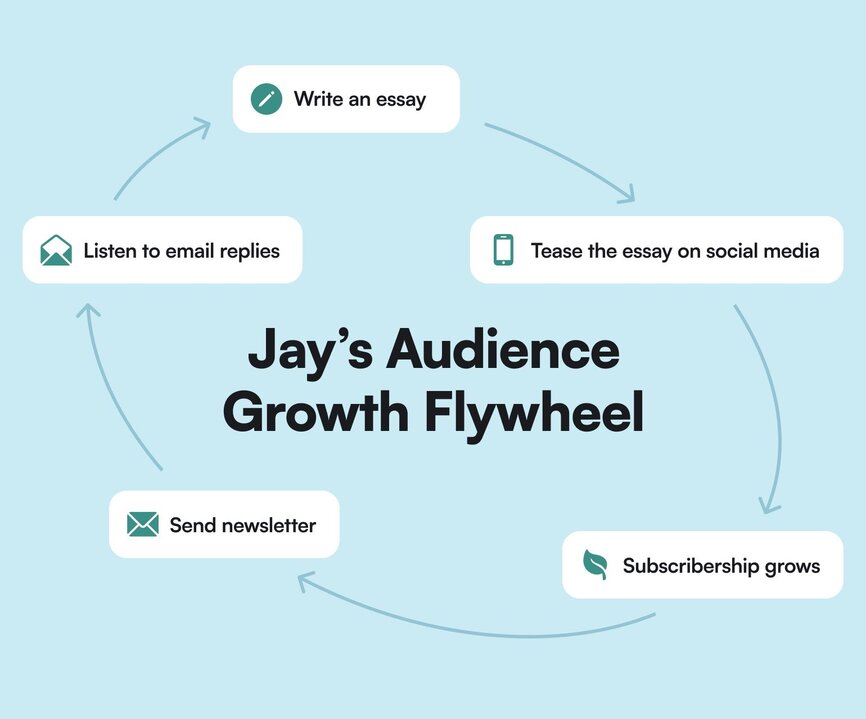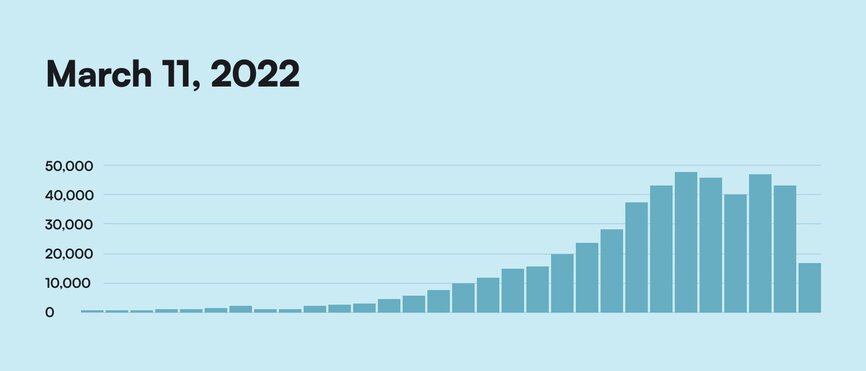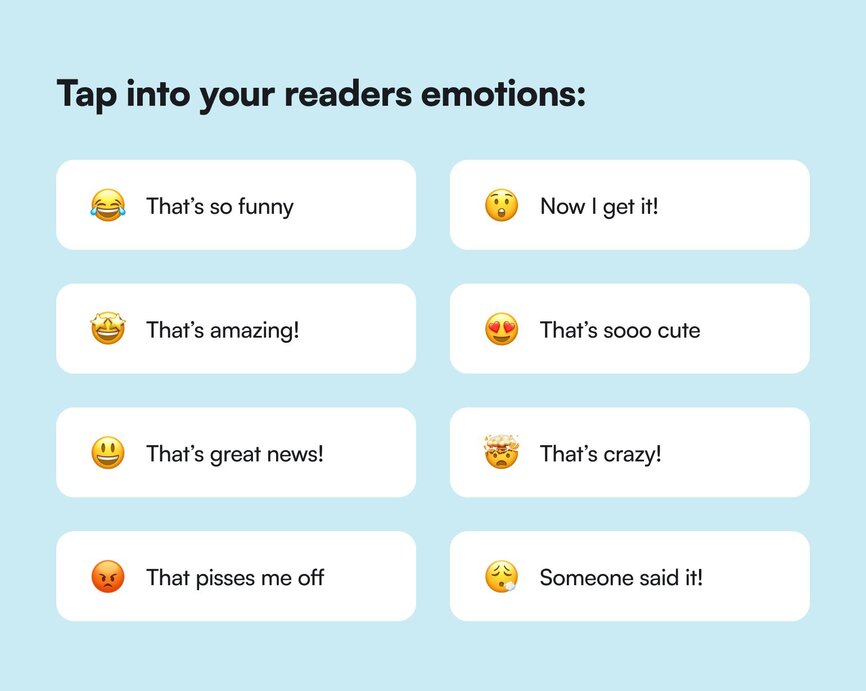6 ways to grow a newsletter using ‘experimentality’
How do you grow a $800k/year business on the back of a newsletter—which grew subscribers 7x in 2 years and pulls in $15k every couple months?
Meet Jay Clouse—the startup tech founder turned teacher for creators—who has changed the game for creators by bringing science into what many consider an art. Jay is the brains, the muscle, and everything else behind Creator Science—which includes a newsletter, podcast, YouTube channel, and courses for creators who want to lean into building a business that works for them via ‘experimentality’.
His newsletter is a massive piece of his business “puzzle” —and he believes that almost every creator should have a newsletter. Not just to future-proof and de-risk your business, but also to help you achieve bigger and better goals.
But writing the newsletter, picking the platform, segmenting the audience… that’s just one part of a big system. Continuously growing and fueling your newsletter list with fresh, relevant content, and finding new marketing experiments to play with is what’s going to get you to the growth you desire.
Jay left his cushy tech job and started Creator Science in 2017. Now, he earns more than ~$800,000 per year with his business—and has 60,000 subscribers to his newsletter. How did his newsletter growth contribute to his business—and how can you learn from his best experiments to catapult your business growth?
The goal
As a creator, you want to build yourself a system, cadence, and playbook for newsletter content creation that fuels audience, lead, and business growth.
One of the best ways to do that is to create a flywheel around your newsletter.
What’s a flywheel? Flywheels are systems to get consistently increasing results with (hopefully) decreasing effort.
Jay has several flywheels in his business that create more outcomes for less work, and one of the best is the Audience Growth Flywheel.

“It’s something that might take a while to get turning, but it just gets easier and easier over time,” says Jay.
For example, Jay writes a newsletter every week, but a conversion rate of 1% from that newsletter leads to much more impact when his newsletter list is 50k vs. 10k.
The playbook
It’s simple, to-the-point, and… excellent. That’s why we’re sharing it here.
1. Build an inviting front door
Some homes look inviting, with season-dependent wreaths, nice landscaping, and a comfy place to have a cuppa on the porch.
Others look like they should be condemned.
Just like in life, you want to make your business look inviting. That’s why we strongly recommend you stay away from vague, general, “mean-nothing” phrases like:
“Get all my tips and tricks for [topic] by subscribing to my newsletter!”
Who’s clicking on that these days? 🙅🏼♀️🙅🏼♀️🙅🏼♀️ Not us.
Jay’s best advice when it comes to an inviting front door is building a lead magnet: “Create something so good you could actually sell it—and then give it away for free.”
Give people the shortest possible road from them hearing about you for the first time, to choosing to hear from you more. The best way to do that is to:
1. Give people a reason to subscribe—or something of value immediately
- A free email or video course where they can learn from you, begin to trust you, and get value right away
- Templates they can implement ASAP
- Quizzes that pull them in deeper
- Communities of like-minded people they can join
- Free challenges that motivate them to do more or better
2. Add social proof
- Ask every person that takes a step into your universe for a testimonial
- Share it on the sign-up page
3. Avoid creating low-value energy-drainers, like
- Checklists
- Short guides
- eBooks
- Lists

2. Never stop adding side doors
The above is the current “front door” for the Creator Science newsletter, but is that the only way Jay wants people to subscribe and find that newsletter? Absolutely heckin’ not.
So how else can you promote your newsletter if not on your main pages?
- Collaborations with other creators or businesses—like newsletter swaps
- Free workshops for other aligned brands
- YouTube videos
- Links in podcast show notes
- Opt-ins within articles
- Free notes at a presentation sent as email
Almost anything you can think of can be a “side door” for your newsletter, if you can get creative enough. But getting people on that list should be your #1 goal.
3. Search engine optimization (SEO)
SEO isn’t just for big businesses. And organic search can give you a massive boost in new eyeballs, subscribers, and fans.
Jay only started focusing on SEO in March 2020, and by October 2021, he had increased organic traffic to his site to ~50k/month.

So, with a little legwork, and a little learning, you can increase your discoverability online and expose your business to hundreds of thousands of new customers and students.
TLDR: Organic search is an “endless advocate” for your business—even when you’re sleeping. 😴
4. Reach the high bar of shareability
If you’ve got a great reason to opt-in, a variety of “side doors” that welcome new subscribers, and you’re slowly learning how to increase your organic traffic, you’re well on the way to building your list.
But organic traffic is not the only way to drive people to your newsletter.
Your current subscribers, followers, and fans sharing your newsletter does two things:
- Pull in like-minded people—which improves the quality of your inbound leads (warm leads vs. randoms who just found you as an answer to a Google search), and
- Create your own recommendation engine (because people are more likely to trust those that their friends trust—the X principle)
Of course, not everybody will share everything—because we’re all so overwhelmed by content—but if your stuff beats the “shareability” bar… Mama, you’ve made it!
“It has to be really good, articulate something we feel, or hit on some core emotion,” says Jay, who likes Shaan Puri’s framework for viral writing. Shaan targets everything he writes to hit one of these 8 emotions:

5. Don't rule out paid acquisition
Most folks know that “paid” and “ads” are important, but they also feel like they may be the evil step brother of the nice, friendly, welcoming organic search.
But paid acquisition (see: paying to acquire new views, visits, or conversions/sign-ups) should only function as a complement to your organic efforts.
What you don’t want to do is create a skeezy Facebook funnel that turns people into a cult.
What you do want to do is open your eyes to the advertising opportunities you may not have seen or considered before, like advertising in complementary:
- Newsletters
- Podcasts
- YouTube
- Google search
You don’t have to dump millions of dollars or hire the best Facebook ad agency known to man.
You just have to… 👇
6. Run experiments!
Jay believes that your biggest breakthroughs as a creator come from experimenting, innovating, and discovering your OWN path—which is why he preaches “experimentality” so much.
What worked for others may not fit OR work for you—but you should experiment to find out what does.
For example, in January 2023, Jay announced a goal to grow his list to 20k subscribers by the end of February through experiments. At announcement time, he was sitting at 17k subscribers.
Out of the 8 planned experiments, he completed 5, with the following conversion rates:
- Free workshop on Creative Mornings converted at 2.20%
Jay shared a link to download his slides and notes with the audience—in return for subscribing to his newsletter. It worked but not as well as it did historically. He might reuse presentations in the future. - Paid promotions converted at an average of 13.25%
He ran 6 campaigns with 2 different partners—Kieran Drew and The Publish Press—for a total spend of $2100. The Twitter/X shoutout and 3 newsletter mentions with Kieran Drew significantly outperformed The Publish Press mentions. (The Customer Acquisition Cost, or CAC, for Kieran was only $2.01 per customer, which is below Jay’s goal of $3 per subscriber.) - Upscribe recommendations converted at a whopping 54.89%
Jay used Sparkloop to grow his newsletter, and when they rolled out a new recommendation engine called Upscribe, he jumped on the opportunity to cross-promote brands his audience would appreciate in the pop-up widget. - Viral social media posts with his Sparkloop “campaigns” converted at 10.46%
He added “if you liked this, you’d like my newsletter” tweets to the end of his threads, link in bios to all his socials, and banners promoting his newsletter to his YouTube. Twitter bio was the most visited, but the plug at the end of Twitter threads was the highest converting, which makes a ton of sense. -
LinkedIn newsletter converted at a gut-wrenching 0.15%
Jay had 40k subscribers to his LinkedIn newsletter, which was almost double his Creator Science one. So he wanted to see if he could transition more of those people to his platform (vs. LinkedIn’s). The conversion was laughably bad for 40k folks, and it’s probably not something he’s going to be doing again.
The results
Jay comes from a family of teachers—so teaching others is in his blood.
Maybe experimenting with what works best for his audience and students is, too.
From 2017 where he had no idea how to build Creator Science, to 2022 when he was experimenting with his newsletter, to now, where his newsletter generates over $1M in total revenue (including ~$100K in sponsorship revenue)...
Over the last seven years, Jay has experimented more than most creators we know—he’s written more than 600 newsletters, which have helped build an audience of 60,000 subscribers who are eager to hear from him, every week. (You can learn more about Jay’s email strategies in his newsletter masterclass.)
Nevermind that he continues to “experiment in public” in his business—whether with email, business strategy, or customer journeys.
Key takeaways
- Don’t knock it till you try it. Organic, paid, cross-promotions, communities… There's a reason that all of those things have been successful for newsletter growth for brands. You’ll never know if they work for yours until you try. The beauty (and fear) around creator life is that it’s kind of the wild west. You simply don’t know what new tools, processes, or strategies will work for YOU. Don’t rule anything out.
- Give away value first. Nobody wants just another newsletter. But everybody wants to learn, to look better, to grow more. Offer value. Build trust.
- Think creator-scientist. You’re running a business, which means that you need to know your goals, your numbers, and your opportunities. You’re undoubtedly thinking about your business all the time anyway, but seeing yourself as an experimenter helps you identify places where you can impactfully grow or learn about your business as it grows. Your business depends on you staying curious.
- Experiments = learning. Failure = learning. That month-long festival of experimentation Jay took on in 2023? He realized after the fact that those 3,000 subscribers didn’t actually lead to more sales or growth for his business, which meant he had a customer journey problem. So, instead of continuing to focus on growing his email list, he decided to refocus on understanding, experimenting, and reinforcing his customer journey.
- Create constraints to supercharge growth. Experiments have limitations. So does your day. So do brands. When Jay first started his newsletter, he sent an email every day for a year. But his subscribers knew and liked how he thought about everything, which meant that his growth was limited to how many people knew him. Then, he dropped down to a weekly cadence and honed in on creator-ship to give subscribers a better idea of what they could really expect to learn here… and his growth exploded.
And if you’re looking for a community platform that has newsletter growth top of mind?
You’re in the right place.
Circle gamifies your members, discussions, events, courses, and content—all in one place, under your own brand. Plus, you get access to our customer community full of handy resources and over 10,000 community builders on the same journey as you.